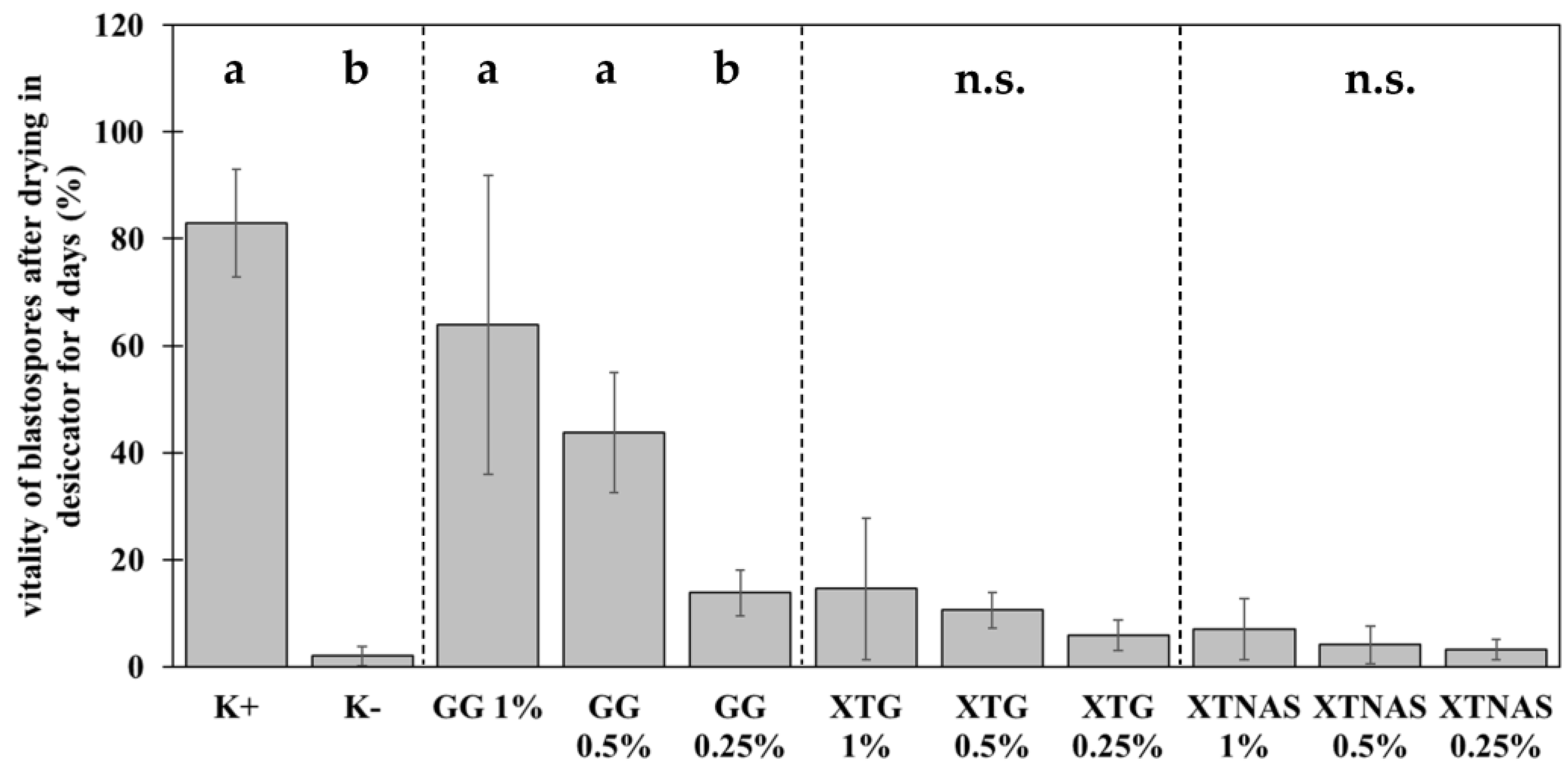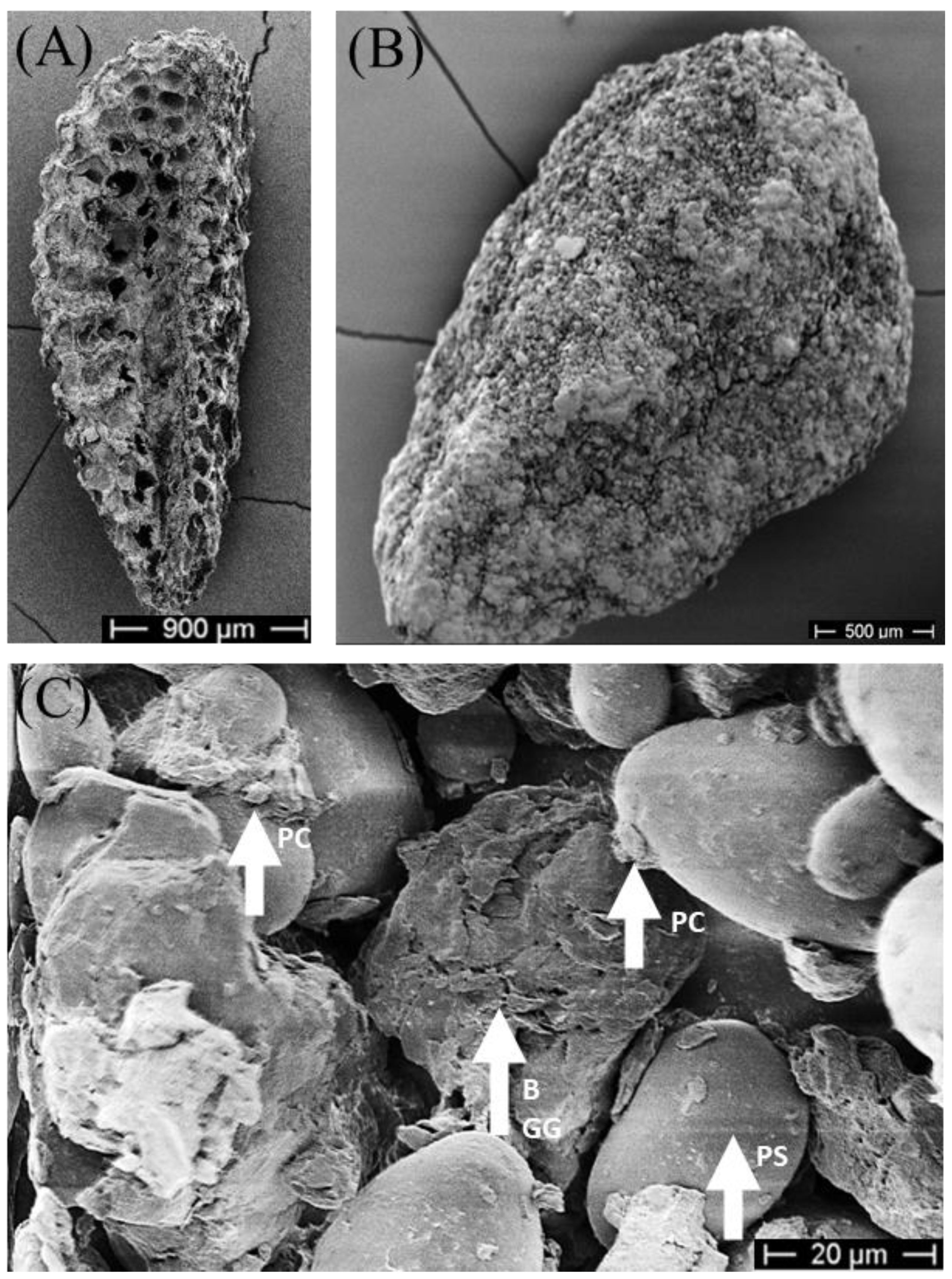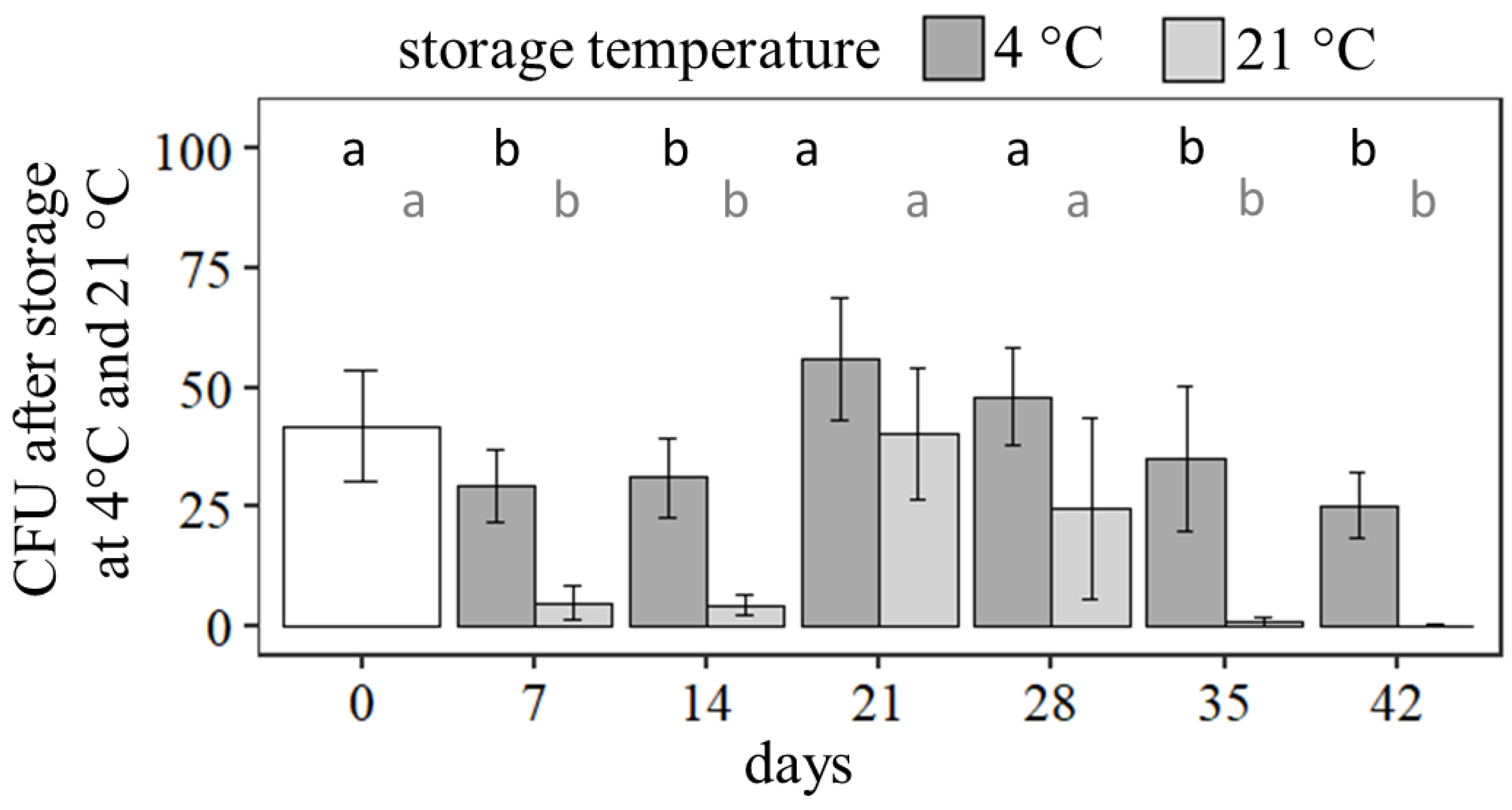Development of a Seed Treatment with Pochonia chlamydosporia for Biocontrol Application
Abstract
1. Introduction
2. Materials and Methods
2.1. Pochonia Chlamydosporia Blastospore Cultivation
2.2. Preliminary Tests
2.3. Seed Treatment
2.4. Storage Tests
2.5. Statistical Analysis
3. Results
3.1. Preliminary Tests—Drying P. chlamydosporia Blastospores in Biopolymers
3.2. Protective Efficiency of Seed Treatments
3.3. Storage Tests
4. Discussion
5. Conclusions
Author Contributions
Funding
Institutional Review Board Statement
Data Availability Statement
Acknowledgments
Conflicts of Interest
References
- Pedrini, S.; Merritt, D.J.; Stevens, J.; Dixon, K. Seed Coating: Science or Marketing Spin? Trends Plant Sci. 2017, 22, 106–116. [Google Scholar] [CrossRef] [PubMed]
- Ma, Y. Seed Coating with Beneficial Microorganisms for Precision Agriculture. Biotechnol. Adv. 2019, 37, 107423. [Google Scholar] [CrossRef]
- Rocha, I.; Ma, Y.; Souza-Alonso, P.; Vosátka, M.; Freitas, H.; Oliveira, R.S. Seed Coating: A Tool for Delivering Beneficial Microbes to Agricultural Crops. Front. Plant Sci. 2019, 10, 1357. [Google Scholar] [CrossRef]
- Petanidou, T. Introducing Plants for Bee-Keeping at Any Cost?—Assessment of Phacelia tanacetifolia as Nectar Source Plant under Xeric Mediterranean Conditions. Plant Syst. Evol. 2003, 238, 155–168. [Google Scholar] [CrossRef]
- Brant, V.; Neckář, K.; Pivec, J.; Duchoslav, M.; Holec, J.; Fuksa, P.; Venclová, V. Competition of Some Summer Catch Crops and Volunteer Cereals in the Areas with Limited Precipitation. Plant Soil. Environ. 2009, 55, 17–24. [Google Scholar] [CrossRef]
- Kubíková, Z.; Hutyrová, H.; Smejkalová, H.; Kintl, A.; Elbl, J. Application of Extended BBCH Scale for Studying the Development of Phacelia tanacetifolia Benth. Ann. Appl. Biol. 2022, 181, 332–346. [Google Scholar] [CrossRef]
- Babbar, S.B.; Jain, R. Xanthan Gum: An Economical Partial Substitute for Agar in Microbial Culture Media. Curr. Microbiol. 2006, 52, 287–292. [Google Scholar] [CrossRef]
- Lachke, A. Xanthan—A Versatile Gum. Reson 2004, 9, 25–33. [Google Scholar] [CrossRef]
- Tako, M.; Kitajima, S.; Yogi, T.; Uechi, K.; Onaga, M.; Tamaki, Y.; Uechi, S. Structure-Function Relationship of a Gellan Family of Polysaccharide, S-198 Gum, Produced by Alcaligenes ATCC31853. ABC 2016, 06, 55–69. [Google Scholar] [CrossRef]
- Grim, R.E. Applied Clay Mineralogy. Geol. Fören. I Stockh. Förh. 1962, 84, 533. [Google Scholar] [CrossRef]
- Mouzon, J.; Bhuiyan, I.U.; Hedlund, J. The Structure of Montmorillonite Gels Revealed by Sequential Cryo-XHR-SEM Imaging. J. Colloid Interface Sci. 2016, 465, 58–66. [Google Scholar] [CrossRef] [PubMed]
- Velloso, C.C.V.; Lopes, M.M.; Badino, A.C.; Farinas, C.S. Exploring the Roles of Starch for Microbial Encapsulation through a Systematic Mapping Review. Carbohydr. Polym. 2023, 306, 120574. [Google Scholar] [CrossRef]
- Dietsch, R.; Jakobs-Schönwandt, D.; Grünberger, A.; Patel, A. Desiccation-Tolerant Fungal Blastospores: From Production to Application. Curr. Res. Biotechnol. 2021, 3, 323–339. [Google Scholar] [CrossRef]
- Kerry, B.R.; Kirkwood, I.A.; de Leij, F.A.A.M.; Barba, J.; Leijdens, M.B.; Brookes, P.C. Growth and Survival of Verticillium chlamydosporium Goddard, a Parasite of Nematodes, in Soil. Biocontrol Sci. Technol. 1993, 3, 355–365. [Google Scholar] [CrossRef]
- Tobin, J.D.; Haydock, P.P.J.; Hare, M.C.; Woods, S.R.; Crump, D.H. Effect of the Fungus Pochonia chlamydosporia and Fosthiazate on the Multiplication Rate of Potato Cyst Nematodes (Globodera pallida and G. rostochiensis) in Potato Crops Grown under UK Field Conditions. Biol. Control 2008, 46, 194–201. [Google Scholar] [CrossRef]
- Manzanilla-López, R.H.; Lopez-Llorca, L.V. (Eds.) Perspectives in Sustainable Nematode Management through Pochonia chlamydosporia Applications for Root and Rhizosphere Health; Springer International Publishing: Cham, Switzerland, 2017; ISBN 978-3-319-59222-0. [Google Scholar]
- Mascarin, G.M.; Jackson, M.A.; Kobori, N.N.; Behle, R.W.; Dunlap, C.A.; Delalibera Júnior, Í. Glucose Concentration Alters Dissolved Oxygen Levels in Liquid Cultures of Beauveria bassiana and Affects Formation and Bioefficacy of Blastospores. Appl. Microbiol. Biotechnol. 2015, 99, 6653–6665. [Google Scholar] [CrossRef] [PubMed]
- Wang, Y.-B.; Yang, Z.-H.; Yu, J.-J.; Zhang, Y.-A.; Xue, J.-J.; Li, Z.; Li, J.-J.; Wang, C.-Y.; Wang, Z.; Hou, J.-G.; et al. Comparison between Conidia and Blastospores of Esteya vermicola, an Endoparasitic Fungus of the Pinewood Nematode, Bursaphelenchus xylophilus. World J. Microbiol. Biotechnol. 2013, 29, 2429–2436. [Google Scholar] [CrossRef] [PubMed]
- Nuaima, R.H.; Ashrafi, S.; Maier, W.; Heuer, H. Fungi Isolated from Cysts of the Beet Cyst Nematode Parasitized Its Eggs and Counterbalanced Root Damages. J. Pest Sci. 2021, 94, 563–572. [Google Scholar] [CrossRef]
- Uthoff, J.; Jakobs-Schönwandt, D.; Schmidt, J.H.; Hallmann, J.; Dietz, K.-J.; Patel, A. Biological Enhancement of the Cover Crop Phacelia tanacetifolia (Boraginaceae) with the Nematophagous Fungus Pochonia chlamydosporia to Control the Root-Knot Nematode Meloidogyne hapla in a Succeeding Tomato Plant. In BioControl; Springer: Berlin/Heidelberg, Germany, 2023. [Google Scholar] [CrossRef]
- Wang, Y.; Li, L.; Li, D.; Wang, B.; Zhang, K.; Niu, X. Yellow Pigment Aurovertins Mediate Interactions between the Pathogenic Fungus Pochonia chlamydosporia and Its Nematode Host. J. Agric. Food Chem. 2015, 63, 6577–6587. [Google Scholar] [CrossRef]
- Strasser, H.; Forer, A.; Schinner, F. Development of Media for the Selective Isolation and Maintenance of Virulence of Beauveria brongniartii. In Proceedings of the 3rd International Workshop on Microbial Control of Soil Dwelling Pests, Lincoln, New Zealand, 21–23 February 1996; pp. 125–130. [Google Scholar]
- R Core Team. A Language and Environment for Statistical Computing; R Foundation for Statistical Computing: Vienna, Austria, 2022; Available online: https://www.r-project.org/ (accessed on 23 November 2023).
- Wickham, H. ggplot2: Elegant Graphics for Data Analysis; Springer: New York, NY, USA, 2009; ISBN 978-3-319-24277-4. [Google Scholar]
- Benjamini, Y.; Hochberg, Y. Controlling the False Discovery Rate: A Practical and Powerful Approach to Multiple Testing. J. R. Stat. Soc. Ser. B 1995, 57, 289–300. [Google Scholar] [CrossRef]
- Accinelli, C.; Abbas, H.K.; Shier, W.T. A Bioplastic-Based Seed Coating Improves Seedling Growth and Reduces Production of Coated Seed Dust. J. Crop Improv. 2018, 32, 318–330. [Google Scholar] [CrossRef]
- Duan, W.; Yang, E.; Xiang, M.; Liu, X. Effect of Storage Conditions on the Survival of Two Potential Biocontrol Agents of Nematodes, the Fungi Paecilomyces lilacinus and Pochonia chlamydosporia. Biocontrol Sci. Technol. 2008, 18, 605–612. [Google Scholar] [CrossRef]
- Cortés-Rojas, D.; Beltrán-Acosta, C.; Zapata-Narvaez, Y.; Chaparro, M.; Gómez, M.; Cruz-Barrera, M. Seed Coating as a Delivery System for the Endophyte Trichoderma koningiopsis Th003 in Rice (Oryza Sativa). Appl. Microbiol. Biotechnol. 2021, 105, 1889–1904. [Google Scholar] [CrossRef] [PubMed]
- Deaker, R. Legume Seed Inoculation Technology—A Review. Soil Biol. Biochem. 2004, 36, 1275–1288. [Google Scholar] [CrossRef]
- Hoben, H.J.; Aung, N.N.; Somasegaran, P.; Kang, U.-G. Oils as Adhesives for Seed Inoculation and Their Influence on the Survival of Rhizobium spp. and Bradyrhizobium spp. on Inoculated Seeds. World J. Microbiol. Biotechnol. 1991, 7, 324–330. [Google Scholar] [CrossRef]
- Burges, H.D. Formulation of Microbial Biopesticides—Beneficial Micro-Organisms, Nematodes and Seed Treatments. Phytochemistry 1998, 59, 361. [Google Scholar] [CrossRef]
- Giavasis, I.; Harvey, L.M.; McNeil, B. Gellan Gum. Crit. Rev. Biotechnol. 2000, 20, 177–211. [Google Scholar] [CrossRef]
- Evans, R.P.; Nelson, C.L.; Bowen, W.R.; Kleve, M.G.; Hickmon, S.G. Visualization of Bacterial Glycocalyx With a Scanning Electron Microscope. Clin. Orthop. Relat. Res. 1998, 347, 243–249. [Google Scholar] [CrossRef]
- Koshland, D.; Tapia, H. Desiccation Tolerance: An Unusual Window into Stress Biology. MBoC 2019, 30, 737–741. [Google Scholar] [CrossRef]
- Gorim, L.; Asch, F. Seed Coating Increases Seed Moisture Uptake and Restricts Embryonic Oxygen Availability in Germinating Cereal Seeds. Biology 2017, 6, 31. [Google Scholar] [CrossRef]
- Liu, X.Z.; Chen, S.Y. Nutritional Requirements of Pochonia chlamydosporia and ARF18, Fungal Parasites of Nematode Eggs. J. Invertebr. Pathol. 2003, 83, 10–15. [Google Scholar] [CrossRef] [PubMed]
- Zeeman, S.C.; Kossmann, J.; Smith, A.M. Starch: Its Metabolism, Evolution, and Biotechnological Modification in Plants. Annu. Rev. Plant Biol. 2010, 61, 209–234. [Google Scholar] [CrossRef] [PubMed]
- Krell, V.; Jakobs-Schönwandt, D.; Patel, A.V. Application of Formulated Endophytic Entomopathogenic Fungi for Novel Plant Protection Strategies. In Endophytes for a Growing World; Cambridge University Press: Cambridge, UK, 2019; pp. 52–66. ISBN 978-1-108-47176-3. [Google Scholar]
- Kuzhuppillymyal-Prabhakarankutty, L.; Ferrara-Rivero, F.H.; Tamez-Guerra, P.; Gomez-Flores, R.; Rodríguez-Padilla, M.C.; Ek-Ramos, M.J. Effect of Beauveria bassiana-Seed Treatment on Zea mays L. Response against Spodoptera frugiperda. Appl. Sci. 2021, 11, 2887. [Google Scholar] [CrossRef]
- Poorna Chandrika, K.S.V.P.; Prasad, R.D.; Godbole, V. Development of Chitosan-PEG Blended Films Using Trichoderma: Enhancement of Antimicrobial Activity and Seed Quality. Int. J. Biol. Macromol. 2019, 126, 282–290. [Google Scholar] [CrossRef] [PubMed]
- Rocha, I.; Duarte, I.; Ma, Y.; Souza-Alonso, P.; Látr, A.; Vosátka, M.; Freitas, H.; Oliveira, R.S. Seed Coating with Arbuscular Mycorrhizal Fungi for Improved Field Production of Chickpea. Agronomy 2019, 9, 471. [Google Scholar] [CrossRef]
- Rivas-Franco, F.; Hampton, J.G.; Morán-Diez, M.E.; Narciso, J.; Rostás, M.; Wessman, P.; Jackson, T.A.; Glare, T.R. Effect of Coating Maize Seed with Entomopathogenic Fungi on Plant Growth and Resistance against Fusarium graminearum and Costelytra giveni. Biocontrol Sci. Technol. 2019, 29, 877–900. [Google Scholar] [CrossRef]
- Turkan, S.; Mierek-Adamska, A.; Kulasek, M.; Konieczna, W.B.; Dąbrowska, G.B. New Seed Coating Containing Trichoderma viride with Anti-Pathogenic Properties. PeerJ 2023, 11, e15392. [Google Scholar] [CrossRef]
- Kuchlan, P.F.; Kuchlan, M.M.M.A.K.; Ansari, M.M. Efficient Application of Trichoderma viride on Soybean [Glycine max (L.) Merrill] Seed Using Thin Layer Polymer Coating. LR 2018, 42, 250–259. [Google Scholar] [CrossRef]
- Mascarin, G.M.; Jackson, M.A.; Behle, R.W.; Kobori, N.N.; Júnior, Í.D. Improved Shelf Life of Dried Beauveria bassiana Blastospores Using Convective Drying and Active Packaging Processes. Appl. Microbiol. Biotechnol. 2016, 100, 8359–8370. [Google Scholar] [CrossRef]
- Silva, D.M.; de Souza, V.H.M.; Moral, R.d.A.; Delalibera Júnior, I.; Mascarin, G.M. Production of Purpureocillium lilacinum and Pochonia chlamydosporia by Submerged Liquid Fermentation and Bioactivity against Tetranychus urticae and Heterodera glycines through Seed Inoculation. J. Fungi. 2022, 8, 511. [Google Scholar] [CrossRef]





Disclaimer/Publisher’s Note: The statements, opinions and data contained in all publications are solely those of the individual author(s) and contributor(s) and not of MDPI and/or the editor(s). MDPI and/or the editor(s) disclaim responsibility for any injury to people or property resulting from any ideas, methods, instructions or products referred to in the content. |
© 2024 by the authors. Licensee MDPI, Basel, Switzerland. This article is an open access article distributed under the terms and conditions of the Creative Commons Attribution (CC BY) license (https://creativecommons.org/licenses/by/4.0/).
Share and Cite
Uthoff, J.; Jakobs-Schönwandt, D.; Dietz, K.-J.; Patel, A. Development of a Seed Treatment with Pochonia chlamydosporia for Biocontrol Application. Agriculture 2024, 14, 138. https://doi.org/10.3390/agriculture14010138
Uthoff J, Jakobs-Schönwandt D, Dietz K-J, Patel A. Development of a Seed Treatment with Pochonia chlamydosporia for Biocontrol Application. Agriculture. 2024; 14(1):138. https://doi.org/10.3390/agriculture14010138
Chicago/Turabian StyleUthoff, Jana, Desiree Jakobs-Schönwandt, Karl-Josef Dietz, and Anant Patel. 2024. "Development of a Seed Treatment with Pochonia chlamydosporia for Biocontrol Application" Agriculture 14, no. 1: 138. https://doi.org/10.3390/agriculture14010138
APA StyleUthoff, J., Jakobs-Schönwandt, D., Dietz, K.-J., & Patel, A. (2024). Development of a Seed Treatment with Pochonia chlamydosporia for Biocontrol Application. Agriculture, 14(1), 138. https://doi.org/10.3390/agriculture14010138





